This week we continue our play-through of the “Totensonntag” Pint-Sized Campaign for Chain of Command. Previous episodes can be found here:
Part 1: Introduction to “Totensonntag”
Part 2: Let the Battle Begin!
Part 3: A Delaying Action
Part 4: Flank Attack!
Part 5: The Fortunes of War
Hopefully our readers will forgive the gap since the last article – summer is always a busy time for vacations, kids off school, work travel, GenCon, etc. It’s been a little while since we last played this campaign, but once I could get everyone in the same room at the same time we picked up right were we left off!
In the last battle, the South Africans brought out the big guns (gun?) and the Germans of the 15th Panzer Division started their transition from focusing on capture to simply bypassing pockets of resistance and pushing through the South African formation. This led to a swift reversal in the number of campaign Victory Points, putting the South Africans in the overall lead for the first time.
For this game, I was fortunate enough to once again have my friends John and Lily reprise their roles as the commanders of the South African and German forces respectively. I again took on the role of referee and documentarian.
The Mission
The scenario for this battle on the campaign ladder is “Attack on an Objective,” which is Scenario #6 from the basic Chain of Command rulebook. This one is a straight-up slug-fest, as there is some piece of terrain on the table (often a bridge or the like) that the attackers must capture. Importantly, there is no short-cut to winning the scenario – the attacker must reduce the defender’s Force Morale to 0 and drive them off. This particular campaign does allow the German side the use of the “Armored Advance” campaign special rule to force a draw (which the German side used in the previous scenario), but a true win involves some hard work.
The “objective” for this scenario was a set of tents representing the 5th South African Infantry Brigade’s headquarters. On the day of the battle in question, the German advance through the South African formation was so swift that the brigade command was completely unable to maintain situational awareness. In fact, the brigade staff had no idea that the command post was even under attack until an adjutant stepped outside one of the command tents and saw German tanks just 300 yards away. Brigadier Bertrand Armstrong and most of his staff were captured. This is one of those crazy things that happens in war, where if you were writing a fictional story about it people would accuse your plot of being unrealistic.
Setup
As this is an odd-numbered campaign turn, the number of burning vehicles is increased by one, bringing the total to 5. This is one of the aspects to the campaign that is interesting, in that as things stretch on, the board becomes more and more cluttered and visibility gets more and more restricted.
The three objective vehicles this time were an ambulance, a supply truck, and a towed artillery piece. Randomizing the location of everything per the campaign rules led to a setup that had the potential to favor the Germans, especially if they got lucky in the Patrol Phase. All of the objective vehicles were positioned toward the southern end of the table (where the Germans would be coming from) and most were obscured from the northern end of the table by smoke. This would potentially give the Germans the ability to rush up and force the surrender of these vehicles without being too exposed to South African anti-tank fire.
Choosing Supports
John arrived first, so we were able to go over his support options in secret – I love the additional “fog of war” of not knowing what your opponent is going to bring. At this point, the South Africans will get 8 points of support. John chose to use two of these to upgrade the last two elements (a Section and a Senior Leader) from Green to Regular. This means that for the rest of the campaign he will no longer be haunted by the “enforced deployment” rule. In essence, the Germans have now pushed all the way through the B Echelon units and are now encountering actual combat units. They are still infantry and woefully under-equipped to handle an armored assault, mind, but regulars none the less. While the amount of support he had on hand would have once again allowed him to take a 25-lb gun, that option was temporarily unavailable to him, as one of his objective vehicles was an artillery train (and I only have one 25-lb model that I use for both). Instead, he chose two 2-lb guns and an additional 2″ mortar. The thinking here was that additional smoke might help him screen his fleeing vehicles better.
- A 2-lb artillery gun with 5 crew and Junior Leader (2 points)
- A 2-lb artillery gun with 5 crew and Junior Leader (2 points)
- A 2″ mortar team with 2 men (2 points)
- Permanently upgrade one Team, Section, or Senior Leader from Green to Regular (1st Section, 1 point)
- Permanently upgrade one Team, Section, or Senior Leader from Green to Regular (Platoon Sergeant, 1 point)
John also opted to use the “Breakout!” wild-card event for the campaign, which gave him two Crusader tanks for free. This represents the last remnants of the British 22nd Armored Brigade – almost completely wiped out in the preceding days of fighting – breaking out across the German line of advance. It also now almost guaranteed that this was going to be messy.
Once Lily arrived, I took her aside an we worked out her supports. For the Germans, the infantry situation is getting dire. Because the Germans have yet to pause in their advance, the tanks are rapidly out-pacing the infantry. This is reflected in the fact that infantry units cost 4 more points than they did originally. That means that a single 3-man engineering team now costs 5 points – as much as a full infantry squad did in the first turn. And that’s before their mandatory transport. This leads to some tough prioritization questions; the Germans get way more points for capturing things intact, but having only a single team means prioritizing only one vehicle for capture. While this would ideally be the artillery train (as it’s worth the most points), that vehicle was very close to the table edge and most likely to escape. She did have an additional point to spend due to the CO’s overall positive opinion of young Leutnant Krauss, and at the end of the day, Lily chose the following:
- A Pre-game Barrage (2 points)
- An Adjutant (1 point)
- A Panzer II C (4 points)
- A 3-man Engineering team (5 points)
- A Kubelwagen with no crew or weapons (1 point)
Editor’s Note: I made a mistake here in that the Pionier units that took part in this battle were mounted in half-tracks, and thus by the rules as written would have had to spend 2 points on an SdKfz 250 or 251 as their mandatory transport. This effectively gave Lily an extra point of free support, so I’ll have to remember that in future Campaign Turns.
In addition, with the destruction of Berndt Ehrenreich’s tank in the last battle, Lily chose to use one of the two “Replacements” allowed to the Germans in this campaign. This reflects the Germans rolling reduced combat groups together, and in this context each replacement represents a single up-gunned Pz III G tank pulled from another platoon. Given that this is a brand new leader, let’s see who he is, shall we? Once again taking to the tables in At the Sharp End we get the following:
Unteroffizier Walter Gehrhart: A strapping, 6-foot tall man from Ansbach, Walter was a 26-year-old office clerk in a bicycle shop before the war. Someone in the army must have thought this meant he was mechanically-inclined – absolutely not the case – and assigned him to the Panzer korps. Well, scheiβe.
This brings Lily back up to 5 tanks in her core platoon.
Force Morale
With a total of +2 to the roll from his own outlook and the opinion of the tank crews in the platoon, the Germans easily netted the maximum Force Morale of 11. Suffering from a -2 from the sense of dread creeping through the men of 5th Brigade, the South Africans rolled a 6, which after the negative modifier was applied gave them their best possible result of a Force Morale score of 9.
Patrol Phase
The Patrol Phase for this mission gives the attacker a choice of whether to use three or four Patrol Markers. One of the things that often gets missed by people new to Chain of Command is that once all of the Patrol Markers are locked down, you can only place a Jump-Off Point from any given marker once.
Most times, both sides start with four markers, meaning you will typically have at least some choice as to how to place your JOPs. But with only three markers, there is the potential to really hose yourself and not get enough “positional diversity” in your markers to allow for good JOP placement. The flip side, of course, is that a cluster of three markers is going to advance up the field faster than a cluster of 4 markers. Given how important it was to get onto the eastern flank of the board, the Germans went with just three markers.
Additionally, the attacker gets D3+1 free moves. With only 3 markers, this has the potential to rocket the attacker up the field. The Germans rolled for crap, however, and only got the minimum two moves. Still, that allowed them to swing to the east and get not one but two JOPs on the eastern board edge. As the South Africans, John was canny here – given that he was using the “Breakout!” wild card, he needed a JOP on the board edge to bring on his free tanks. This he did, with a JOP sited pretty far along the western edge. This would prove to be pivotal later.
Finally, the scenario allows the defender to place an optional JOP on the objective itself. John took advantage of this, tucking his 4th JOP into the big tent.

The Battle
Regardless of Force Morale, the attacker takes the first phase in this scenario. That means the Germans will be starting off as usual.
Turn 1, Phase 1 (German): 33311 – No longer needing to sweat a pre-game barrage and with an Adjutant directing traffic in the rear, this was about as good a roll as the Germans could have asked for in terms of first phase deployment. Lily deployed Krauss and two other tanks, all with their main guns and hull MGs on overwatch.
Krauss signaled an overall advance over the platoon net. Leading from the front, he cautiously approached the cluster of vehicles and tents to his front and right. Dieter Bauer’s tank formed up on his left, and just past him Wilhelm Mauser anchored the right flank. Looking back over his left shoulder, Krauss could see a Kubelwagen sticking close to him. The men inside were members of the 33rd Pioniers, an engineering team that had rustled up a car somewhere and were now using the advancing tanks as cover. Given how many casualties the infantry had already sustained today, these engineers weren’t taking any chances.
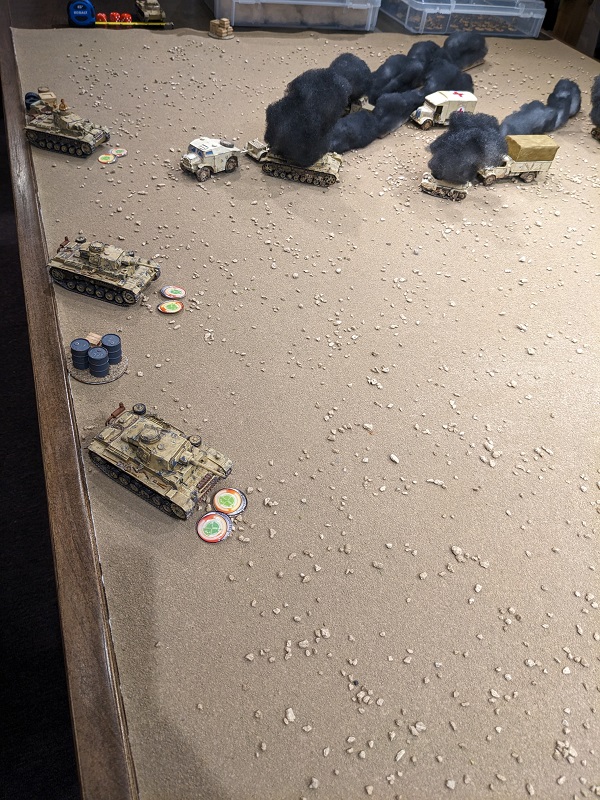
Turn 1, Phase 2 (South African): 65431 – Now feeling the sting of the pre-game barrage, the South Africans try and fail to bring on one of their 2-lb AT guns. Not needing to lose any dice to enforced deployment and not wanting to risk capture, John used his 1 to try to zoom the Morris Quad and its towed gun off the table. Krauss immediately triggers his overwatch, a 50mm high-explosive shell striking the gun tractor and starting it on fire. An inauspicious start for the South Africans.
Turn 1, Phase 3 (German): 66541 – Adding insult to injury, the Germans get an early double phase. Commanding his driver to step on it, Krauss’ tank lunged forward. The driver of the still idling supply truck had no idea how close the enemy tanks were until he saw one looming out of a nearby smoke plume, its hull MG pointed menacingly in his direction. He kept his hands where he hoped the Germans could see. The Pioniers in the Kubelwagen were quick to follow up.
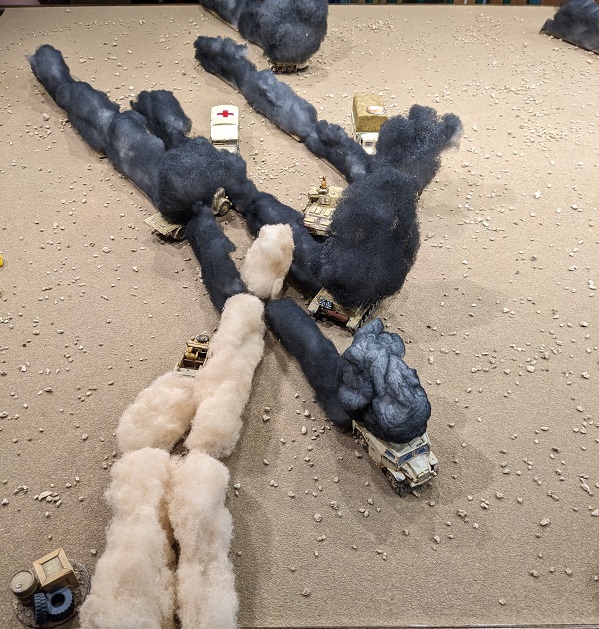
Turn 1, Phase 4 (German): 5322 – Jürgen Lendt’s #2 tank deployed onto the field, also on overwatch. Lily could have combined the 2s to activate Krauss to get the other tanks moving via radio, but with no enemy yet visible she decided to keep everyone where they were and still on overwatch.
Turn 1, Phase 5 (South African): 55321 – Finally the South Africans manage to bring on a 2-lb gun.
As his tank halted, Dieter Bauer scanned to his front and was able to get a better look at the cluster of tents ahead. He thought he saw some men milling about next to one of them, but it wasn’t until his line of sight cleared the edge of the mass of tan canvas that he realized they were servicing an AT gun. He saw the muzzle flash, at this range followed almost instantly by an ear-shattering CLANG! as the solid 2-lb shot struck and rebounded off his turret mantlet. Quickly calling out the target, both the main gun and the hull MG opened fire on the shockingly close South African gun. The depression angle on the main gun was too high and the shot sailed overhead, but Dieter saw one of the gun crew go down to machinegun fire.

John also tried to bring on one of his Crusader tanks, but again the barrage frustrated his efforts.
Turn 1, Phase 6 (German): 65431 – Having already been struck once, there was no point in staying still; Bauer’s #5 tank rumbled into a slow advance and got off another shot at the 2-lb gun with its 50mm cannon. Again the shot was high. Jürgen Lendt also contributed some HE to the party and another of the gun crew was killed. The Kubelwagen also advanced, bringing it into a position where the men inside would be able to dismount and effect the capture of the supply truck. With a lot of smoke and dust between him and the newly-revealed AT gun, Krauss got greedy – he advanced his tank slightly, taking the ambulance into the arc of his hull-mounted MG and training his co-axial MG on the supply truck. Now both South African support vehicles were forced to surrender.
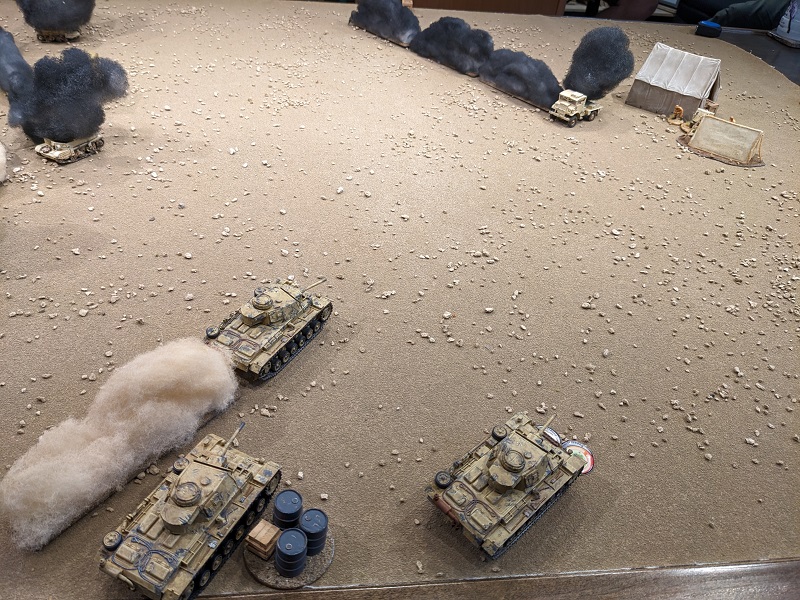

Turn 1, Phase 7 (South African): 66321 – Now it was the South Africans’ turn for a double phase. Knowing that a bird in the hand was invaluable, John opted to combine dice to activate the #1 2-lb gun already deployed. It again opened fire on Dieter Bauer’s tank, and this time the shot was better placed, knocking out the hull MG and putting 2 points of Shock onto Bauer’s crew. And finally, one of the Crusaders made it through the barrage, as Wilhelm Mauser was about to find out…
When Duncan Phillips first joined the 3rd County of London Yeomen, the unit had been a “cavalry” unit comprised mostly of armored cars. In the intervening years they had been attached to the 22nd Armored Brigade and upgraded to tanks. He remembered his pride at his unit being selected as one of those to be given the brand new Crusader tanks, for which their current operation was named. That was before they discovered that the things drank water like hogs and overheated if you looked at them cross-eyed. And the last few days had been a nightmare. After the initial exuberance of racing across the Western Desert into Libya had passed, they had finally come into contact with the enemy – and it had not gone well. In the last two days more than half of the Brigade’s 79 tanks had been destroyed. Their sister unit (the 4th County of London Yeomen) had been reduced to just 5 operational tanks during action against the Germans at Sidi Rezegh last night.
But now they had been ordered to make a charge across the enemy’s line of advance to relieve the pressure on the 5th South African Infantry Brigade, who were being rather roughly handled by the Jerries at the moment. This might just be a chance at revenge! Finally spotting a German tank, Phillips ordered his gunner to open fire. Though increasingly considered somewhat underpowered, at this range the 2-lb main gun was sufficient. The shot struck the enemy tank hard, and Phillips could see pieces of armor blown off in the vicinity of the hull gunner’s position.

The clever bit here is that the Allied JOP on the western table edge has allowed John to deploy his tanks in a position to get shots against the side armor of Wilhelm Mauser’s tank. Paired with the AT gun in the camp, it’s actually hard for the Germans to not be giving a flank shot to someone, which is generally bad news.
Turn 1, Phase 8 (South African): 5321 – Trained like a well-oiled machine, Phillips’ crew loaded a new round into the breach and tagged Mauser’s panzer again. This time the hit added another point of Shock and panicked the driver, who would not be able to be activated in the next phase. With 3 Shock now, Mauser’s crew was dangerously close to bailing out.
The #1 2-lb AT gun once again connected with Dieter Bauer’s tank, but again the shot bounced harmlessly off its frontal armor.
Turn 1, Phase 9 (German): 43222 – This was not a great roll for the Germans. One of the things that you cannot do via radio is rally off Shock, so the 3 had to be spent on getting young Wilhelm Mauser to shout down his panicking crew and keep them focused on their jobs (spending both his CI to reduce Shock). Krauss’ three command initiatives were then spent trying to make something happen: 1 CI went to command Mauser’s gunner to fire at the newly-appeared Crusader, but the shot was a miss. Dieter Bauer’s tank had better luck, swiveling the turret around to also take a shot at the low-slung British tank. Their aim was true, inflicting 2 Shock and forcing the Crusader to retreat off the table. The final CI was spent on commanding Lendt to brass up the pesky 2-lb AT gun, but the shot only inflicted a single point of Shock.
Turn 1, Phase 10 (South African): 64332 – More deployments made it through the barrage, this time the South African 1st Section and the Platoon Sergeant. The sergeant rallied off the #1 2-lb gun crew’s Shock, which let the crew chief spend both his CIs sighting the gun.
Sgt Vikus Vanderploeg knew full well that he would probably end the day either dead or as a prisoner of war, but for the time being he and his proud men of the 2nd Regiment Botha were prepared to continue fighting until the end. Also, the cowardly bastards driving their transport had already sped off, more or less stranding them. But right now, their job was to get into covering positions where they could secure the nearby 2-lb AT gun’s immediate safety should any enemy infantry appear. Vanderploeg knew that the crew – who had been ramming rounds downrange as fast as they could load them – were starting to get rattled by the proximity of the onrushing German forces. “Steady, lads, we’ve got your back!” he said as he and his men settled in. He could see the relief in the eyes of the gun crew’s chief, who set about barking through the orders of the loading and firing sequence with renewed vigor.
The 2-lb gun’s shot again struck Dieter Bauer’s tank, this time inflicting a point of Shock and preventing that tank from activating in the next phase. Things were starting to look hectic for the Germans.
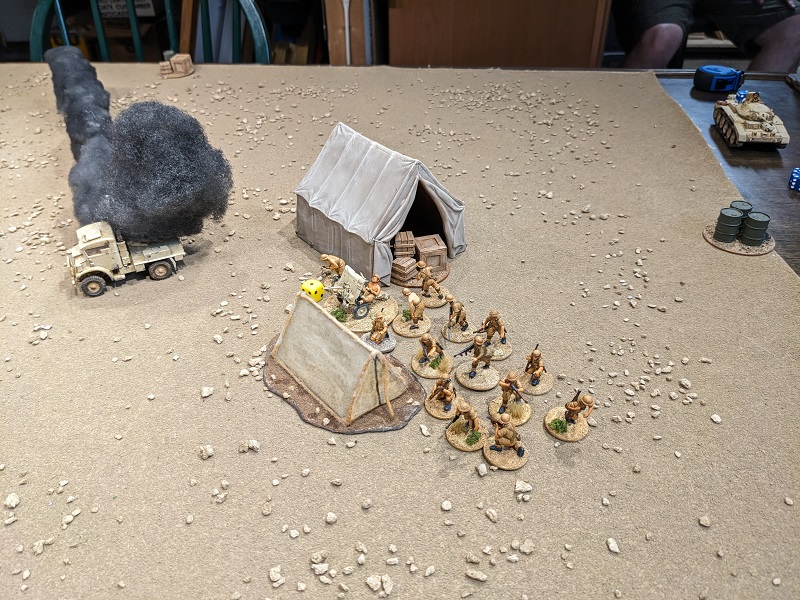
And that was before the Crusader tank re-entered the field – and brought a friend! Perhaps still rattled by the German tank shell that had just struck their vehicle, Phillips’ main gun missed its mark. But his platoon-mate had better luck, the second Crusader cannon’s solid shot striking young Wilhelm Mauser’s tank in its magazine. A massive explosion and a rapidly expanding pall of smoke could be seen where just moments before a tank had been. The entire crew was killed instantly.
The combined loss of an AFV and an NCO killed caused a 4-point drop in German Force Morale, bringing them down to a 7 in one fell swoop.
Oh shit, now it’s on!

Aside: It’s not technically in the rules but I gave John a choice here – make the roll to bring the first Crusader back in through the barrage but remove all of its Shock, or bring it back on without a roll but still having the 2 points of Shock that had been inflicted in the previous phase. He chose to re-deploy without a roll and keep the Shock. Sometimes these kids of edge cases pop up where it’s not exactly clear what should happen under the rules as written, and when these situations crop up I like to put the choice to the players.
Turn 1, Phase 11 (German): 65433 – Lendt’s panzer advanced and took a pot-shot at the 1st Crusader but missed – probably as a result of the hasty repair done in the field after the 3rd battle. The trusty Pz IIC deployed and unloaded with its 20mm autocannon at the #1 2-lb gun, but miraculously the shots completely missed. Finally, the engineering team in the Kubelwagen jumped out and dashed over to take control of the South African supply truck. Knowing that things were already getting dicey and that she needed to score some points, Lily opted to use her Chain of Command Die to end the turn. The Pioniers drove the captured truck off the table, netting the Germans 3 Campaign Victory Points regardless of whatever else happened.
The downside, of course, is that ending the turn also ends the pre-game barrage.
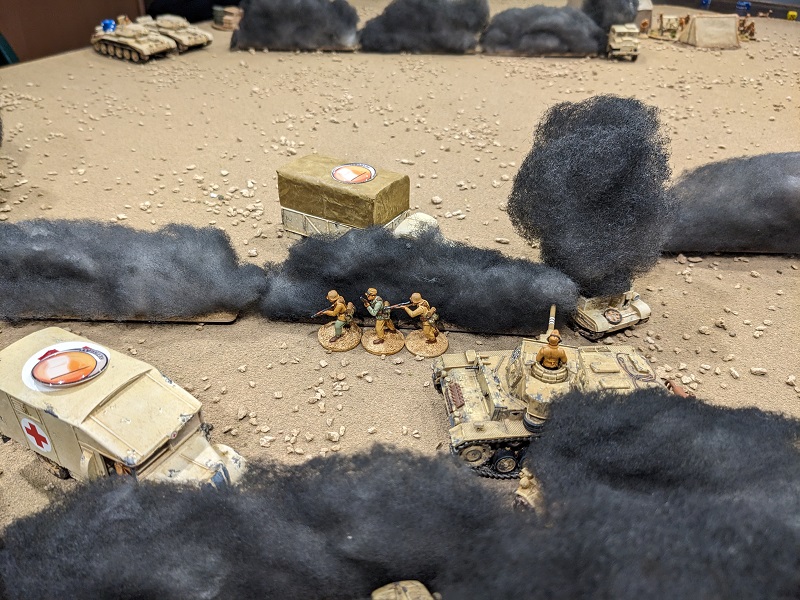
Turn 2, Phase 1 (South African): 42222 – Unable to bring on any new anti-tank units or activate any of the tanks, John did the only thing left open to him – activated Sergeant Vanderploeg, who commanded the #1 2-lb AT gun to fire at Lendt’s panzer. Unfortunately this shot was a miss and play passed right back to the Germans
Turn 2, Phase 2 (German): 43221 – The 20mm autocannon and turret MG of the Pz IIC once again rattled at the #1 2-lb gun, inflicting another kill. Meanwhile, Dieter Bauer spent one CI to command his driver to advance and the other to rally off a point of Shock. Krauss then activated Bauer’s gunner via radio, taking a shot at the 1st Crusader. The shot was a hit, inflicting a point of Shock and once again forcing the British tank to reverse off the table. Krauss spent another CI activating Lendt’s gunner via radio, also shooting at the #1 2-lb gun. Again the shot had no effect.
Aside: One of the cool things about the flexibility of both the unit activation and the time scale of phases means that there can be a whole host of narrative reasons for why something does or doesn’t happen. Combined with randomized movement distance it makes for a very dynamic situation. You rolled for crap and your unit didn’t move far enough when dashing from cover to cover, ending up exposed in the middle of the street? There are loads of things that might have caused that – maybe Private Porkins tripped on a loose cobblestone and his friends ran back to pick him up. Maybe the order to sprint wasn’t fully understood and the men of the unit thought that trying to sneak was what was called for. Or maybe the Germans manning the MG-42 in the nearby barn spotted a hint of movement early and were quicker to bring their gun into action that you thought they’d be. Whatever the reason, it’s cool because it gives you creative license to explain things however makes for the most compelling story. For example, this is the second time that fire from Lendt’s main gun has had exactly zero effect. Did those shots just miss? Or did they actually never even happen in the first place? Given that Lendt’s main gun was damaged in Game 3, we can weave that little tidbit into our ongoing narrative, like so:
“Cursing and contorting himself in the commander’s seat, Lendt kicked at the carriage mount of the 50mm gun beside him, trying to jar loose whatever was stuck. A solid 2-lb shell they’d taken to the turret a few hours ago had deeply dented the turret’s armor and knocked something in the gun mount out of true. Originally the breach wouldn’t close, meaning the gun couldn’t be fired at all. Last time they’d stopped for fuel they’d taken a hammer and a pry-bar to the mount and at least now the breach could be closed and the recoil carrier would cycle, but at present there was instead something sticking in the trigger mechanism. Twice now he’d commanded his gunner to fire only to hear a dull-click and have nothing happen. It was one thing to not have their main gun available when taking on infantry – the hull and co-axial machineguns were more than sufficient and in many ways preferable tools for that – but with British tanks coming at them, having a working main gun was now a matter of life and death.”
See? This is one of the things I absolutely love about this game, it just lends itself naturally to great narratives developing on the fly! End of aside.

Turn 2, Phase 3 (South African): 44321 – Using the 3, Phillips’ Crusader came back on the board yet again, the doughty Londoner spending 1 CI to rally off a point of Shock and the other ordering his gunner to engage Bauer’s tank. The shot was a hit, but was a touch high and just skimmed across the top of the turret to no discernible effect. Adding the 1 and 2 saw the deployment of the second South African 2-lb gun, which also engaged Bauer’s panzer. This was also a hit and knocked out the main gun. This is a “Bad Thing” and caused a -1 drop to the German Force Morale. Finally, Sergeant Vanderploeg activated the crew manning the #1 gun. They took a shot at Lendt’s machine and scored a solidly penetrating hit sufficient to destroy the tank. It didn’t explode, but at the very least it was now on fire, greasy black smoke boiling out from its engine compartment. The loss of another AFV brought the German Force Morale down a further 2 points to a 4. Now Lily would be rolling fewer dice for each activation. Worse, of the tanks on the table only Krauss’ had a fully functional 50mm main gun (the best weapon in the platoon’s arsenal for taking on the British tanks). All of a sudden, things were looking dire for the Germans!
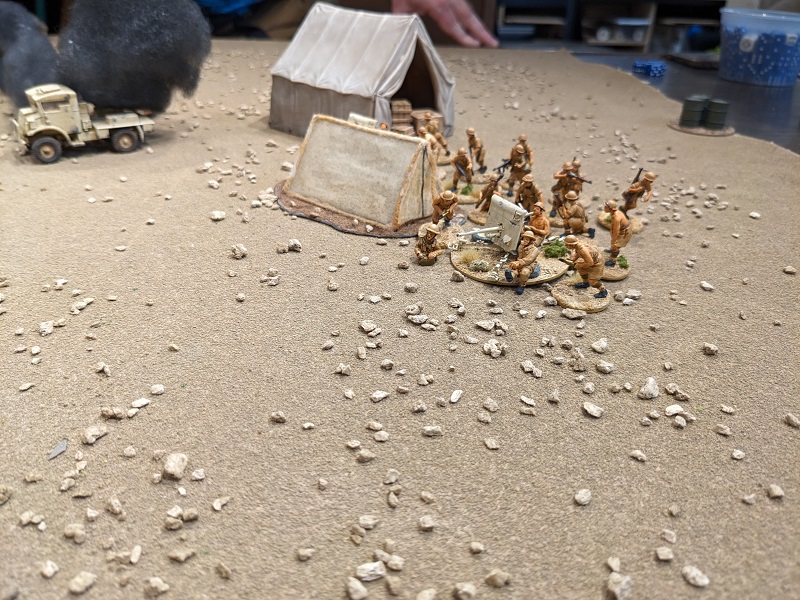
Turn 2, Phase 4 (German): 3211 – At least this roll provided some decent activation options. Once again smoothly transitioning to an armored advance, Lily opted to move the Pz II C flat out towards the northern board edge. The speedy little tank advanced a whopping 18″, which actually brought it out of line-of-sight of one of the Crusaders and out of arc-of-fire of both 2-lb AT guns! It also put it pretty close to the edge. Then, seriously contemplating his situation, Leutnant Krauss chose war crimes. Fortunately, the roll to shoot the ambulance came up snake-eyes, again missing a stationary enemy vehicle at extremely close range. Or was it a miss? Per our aside above, maybe it happened like this:
Krauss’ radio crackled and before the signal cut out to static he could hear Lendt shouting ‘Feuer! Feuer!’ and knew that another tank in his platoon was down. The Pz II C that had been rolling with them for most of the afternoon was already speeding to the north, and there was precious little time to lose. Angry at the loss of Wilhelm Mauser, Krauss gritted his teeth and commanded his gunner, “Los!”
But unlike the last time they found themselves in this situation, his gunner’s compliance was not immediate. In fact there was no compliance at all. Instead, the man was looking up at him incredulously, shocked that his Leutnant would command him to fire on an ambulance, and pointedly took his hand off the trigger.
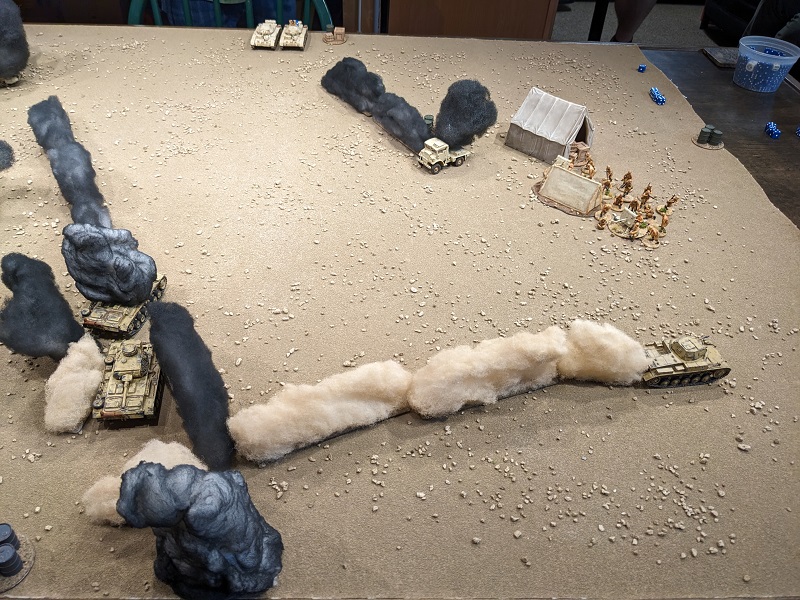
Turn 2, Phase 5 (South African): 44321 – With the Pz II C now out of their arc of fire (or completely out of visibility behind a tent as was the case with the #1 gun), Sergeant Vanderploeg ordered both gun crews to re-site their weapons. Alas, that meant they’d be unable to fire this phase.
Aside: The 2-lb gun is a pretty nimble little beast as AT guns go. It’s mounted on a cranked swivel and the carriage wheels can be knocked on or off in under 45 seconds. I think in the future I’ll allow a light AT weapon that is swiveling in place to “move and fire at half effect” much like infantry. Since fire against vehicles rolls 2D6 to hit, it then stands to reason that “half effect” means making the roll at 1D6. That would still allow you to hit a target in the open (needing a 5+), although in this case the Pz II C moving flat out would need a 6 to hit. But at least it’s a chance.
The 2nd Crusader was the only one that had line-of-sight to the speedy Pz II C, but its shot missed. With only one chance left, Phillips ordered his driver forward at a slow advance and had his gunner fire. A hit! And on the side armor no less! This brief exultation turned immediately to horror as John rolled his 5 dice for armor penetration and got zero successes.
Now all the tension turned to Lily’s armor save. If she could roll a single 5+ on three dice, the little panzer would bounce the hit completely. But alas, she couldn’t get any successes either, resulting in a roll on the “0 net hits” table. There was only one roll that would absolutely undo her plans here, and of course she rolled it: “halt and engage firer next phase.” Unable to move and with a whole mess of AT weapons now pointed at its side armor, the little tank’s fate was an almost foregone conclusion.

Turn 2, Phase 6 (German): 6422 – One of Krauss’ CIs was spent on the mandatory engagement of Phillips’ Crusader by the Pz II C, but the shot went wide and was a complete miss. That left two more CIs…
Yelling incoherently, Krauss wedged himself down beside his dumbfounded gunner, grabbed the firing assembly, and lit off the 50mm cannon. Clambering back up into his seat to look out the vision blocks in his cupola, for the second time in as many hours Krauss was stunned as the vehicle sat intact before him, a perfect 50mm hole in its thin, sheet-metal side where the HE round had passed cleanly through and not met enough resistance to detonate. Now fully aware that the German tank crew was not taking prisoners, the ambulance driver slammed his vehicle into reverse and began backing away as fast as he could, churning up a cloud of dust in his wake. Krauss weakly ordered the hull gun to fire as well, but wasn’t surprised when his gunner claimed to not be able to spot the target through the dust…
Intentionally firing on an ambulance has the same effect in this campaign as intentionally firing on a medic does in the core game – it’s an instant and automatic morale hit for the firing side. This move brought the German FM down to 3.
Turn2, Phase 7 (South African): 54322 – Sergeant Vanderploeg ordered both 2-lb gun crews to open fire, which they happily did. The first hit, adding 2 Shock and killing the Pz II C’s driver, removing any remaining faint hope of escape. The second also hit, and thanks to the weak side armor netted enough penetration successes to destroy the tank for good. It didn’t explode, but it was definitely out of action. German Force Morale fell another point to 2. Finally, Phillips took at shot through the smoke at Krauss’ command tank, miraculously scoring a hit even through the heavy obscuration. The hit inflicted a point of Shock and prevented the gunner from activating next phase.
Faced with mounting losses and no realistic hope of securing an “Armored Advance,” Lily chose discretion as the better part of valor and opted to retreat.
The reverberation caused by an enemy tank shell hitting his vehicle was enough to rouse Krauss out of his murderous rage. Seeing no alternative but to regroup, he ordered an immediate withdrawal over the platoon radio net.
Postgame Campaign Stuff
Woof, that was bloody. But even despite the stinging loss, the Germans were able to score some Campaign Victory Points in this scenario. They gained 1 point for destroying the towed artillery train and got 3 points for capturing the truck full of badly-needed supplies.
But because it was a loss, the CO’s opinion drops by -1 to a +3. That’s still enough to get Krauss an extra point of support for when he next tackles this mission, but only just. Worse, losing the crews of three tanks (one of which exploded and killed its NCO) does a number on the platoon’s opinion of Krauss’ leadership skills. All combined, the effects of the losses crater the German men’s opinion of their Leutnant by -4 points, down to a mere +1. This means that the Germans will no longer be receiving a Force Morale bonus from their ebullience. No doubt word has gotten around of Krauss engaging in war crimes, badly shaking the men’s confidence in their commanding officer. Undeterred by (or perhaps ignorant of) the change, Krauss’ outlook remains “Sociable,” which will still grant the Germans a +1 to the roll in the next mission.
For the South Africans, the difference in Force Morale means all of their casualties are discounted. Thus, the overall opinion of the men of the 5th South African Infantry Brigade rises 2 points to a -5. They’ll still take a penalty to their Force Morale roll for the next game, but it will only be a -1.
But for the South Africans, the big win was destroying three panzers (1 point each). Better yet, forcing the Germans to withdraw allowed the ambulance to escape, giving them another +3 Victory Points for a total of 6. This brings the campaign totals to:
South Africans: 26
Germans: 20
Debrief
Well, it took 5 campaign turns, but the South Africans were finally able to hand the Germans their first outright loss. Still, it was an exceedingly narrow thing. It’s hard to describe just how close the Germans were to getting a tank off the northern edge of the table and forcing another draw.
This is one of those things that’s great about wargames – the tension and the drama that can be created on the tabletop! When Lily’s Panzer II C went racing for the South African baseline, it moved out of the line-of-fire of both 2-lb AT guns and one of the Crusaders. The first Crusader completely missed its shot and the second got zero armor penetration results (even rolling five dice needing 4+ due to a hit in the weaker side armor). Had Lily rolled a single 5+ on three dice, the little Panzer could have kept going in the next phase. Even with zero net hits there’s a 33% change of a “no effect” result being rolled. But that result of “halt and engage firer in the next phase” pretty much doomed the little tank – and with it the Germans’ hopes to squeak out another “Armored Advance.”
Ultimately what this is costing the Germans is time, because having lost the scenario the Germans will have to try it again in the next Campaign Turn. Next time the South Africans won’t be getting any free tanks, so at least there’s that. But there are only 6 scenarios in the campaign ladder, and the Germans get 2 points for every remaining possible Campaign Turn (out of 10) left over after they win the 6th and final scenario. Now the earliest they can finish the campaign is Turn 7. So in addition to any other losses, being forced to withdraw cost them another 2 Victory Points in the abstract.
Aside: People often don’t believe me when I tell them that the balance in this campaign slightly favors the South Africans. They only see the initial condition of tanks vs green infantry and think, “Man, the saffers are screwed!” But the presence of the objective vehicles (and the resulting Victory Points for their escape or capture) and the gradual stiffening of the South African resistance is not to be underestimated. Canny South African players can make this campaign really difficult on the Germans, especially if they get a few lucky breaks.
Also much like the last game, had Krauss been a competent gunner the score would have been much closer. Destroying the ambulance would have resulted in the Germans having +4 VP to the South Africans’ +3 VP and the Germans would have gained ground rather than losing it. As it stands, the South Africans are sitting on a pretty respectable lead. But Krauss still has tanks and fuel, so let’s see if he can get across the finish line.
Speaking of which, losing two tanks from the core platoon is costly. The Germans only have the ability to replace one of them, so the core platoon is now only 4 tanks. That seems like a lot, but given that there are at least two battles left to get to the end of the campaign, it puts the Germans in the unenviable position of needing to spend precious support points bulking out their core platoon strength. There’s a limit to how many tanks the Germans can reliably command on the table at once, but there were 5 panzers on the field at one point in this game. Just like their historical analog, the Afrika Korps cannot afford to sustain these kinds of losses for long.

Huge thanks again to John and Lily for another nail-biter game. I’m going to try my best to make sure that we don’t have such a long gap until the next installment. Stay tuned!
Questions, Comments, suggestions? Contact@goonhammer.com or leave a comment below!


